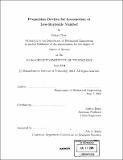Propulsion devices for locomotion at low-Reynolds number
Author(s)
Chan, Brian, 1980-
DownloadFull printable version (7.576Mb)
Other Contributors
Massachusetts Institute of Technology. Dept. of Mechanical Engineering.
Advisor
Anette Hosoi.
Terms of use
Metadata
Show full item recordAbstract
We have designed, built, and tested three novel devices that use low-Reynolds number flows for self propulsion. The three-link swimmer is designed to swim through in a free viscous fluid using cyclic flipping motion of two rigid fins attached to a rigid midsection. Robosnail 1 uses lubrication pressures underneath a flexible, sinusoidally waving boundary to generate thrust, and Robosnail 2 uses five independently controlled translating feet segments to move on a layer of 8 percent Laponite, a shear thinning clay suspension which gives it the ability to adhere to and scale inclines and inverted surfaces. The three link swimmer was found to travel up to 0.034 body lengths per four-stroke cycle, Robosnail 1 was found to move at a speed of roughly half the wave speed of the foot (measured with respect to the snail), a result consistent for wave speeds between 0 and 2 cm/s. Robosnail 2 was able to move forward at all inclines from zero to 180 degrees inverted, with back-slip ranging from 40 to 80 percent.
Description
Thesis (S.M.)--Massachusetts Institute of Technology, Dept. of Mechanical Engineering, 2004. Includes bibliographical references (leaves 65-66).
Date issued
2004Department
Massachusetts Institute of Technology. Department of Mechanical EngineeringPublisher
Massachusetts Institute of Technology
Keywords
Mechanical Engineering.